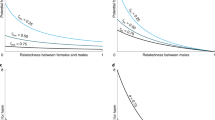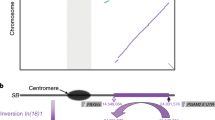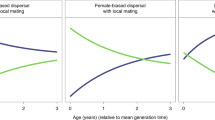Abstract
Dispersal determines gene flow among groups in a population and so plays a major role in many ecological and evolutionary processes. As gene flow shapes kin structure, dispersal is important to the evolution of social behaviours that influence reproduction within groups. Conversely, dispersal depends on kin structure and social behaviour. Dispersal and social behaviour therefore co-evolve, but the nature and consequences of this interplay are not well understood. Here, we show that it readily leads to the emergence of two social morphs: a sessile, benevolent morph expressed by individuals who tend to increase the reproduction of others within their group relative to their own; and a dispersive, self-serving morph expressed by individuals who tend to increase their own reproduction. This social polymorphism arises due to a positive linkage between the loci responsible for dispersal and social behaviour, leading to benevolent individuals preferentially interacting with relatives and self-serving individuals with non-relatives. We find that this linkage is favoured under a large spectrum of conditions, suggesting that associations between dispersal and other social traits should be common in nature. In line with this prediction, dispersers across a wide range of organisms have been reported to differ in their social tendencies from non-dispersers.
This is a preview of subscription content, access via your institution
Access options
Access Nature and 54 other Nature Portfolio journals
Get Nature+, our best-value online-access subscription
$29.99 / 30 days
cancel any time
Subscribe to this journal
Receive 12 digital issues and online access to articles
$119.00 per year
only $9.92 per issue
Buy this article
- Purchase on Springer Link
- Instant access to full article PDF
Prices may be subject to local taxes which are calculated during checkout





Similar content being viewed by others
Change history
11 December 2017
Owing to a technical error, some text was missing in the originally published version of this Article. In the last paragraph of the Discussion section, the second sentence should have read “Yet, the selection that associates dispersal and social behaviour in our model will influence evolution under most ecological settings because it depends only on kin structure, which, due to limited dispersal and the spatial scale of social interactions, is ubiquitous in nature47.” This error has now been corrected in all versions of the Article.
References
Clobert, J., Baguette, M. & Benton, T. G. Dispersal Ecology and Evolution (Oxford Univ. Press, Oxford, 2012).
Ronce, O. How does it feel to be like a rolling stone? Ten questions about dispersal evolution. Annu. Rev. Ecol. Evol. Syst. 38, 231–253 (2007).
Hamilton, W. D. The genetical evolution of social behaviour. I. J. Theor. Biol. 7, 1–16 (1964).
Frank, S. A. Foundations of Social Evolution (Princeton Univ. Press, Princeton, 1998).
Hamilton, W. D. & May, R. M. Dispersal in stable habitats. Nature 269, 578–581 (1977).
Cote, J., Clobert, J. & Fitze, P. S. Mother–offspring competition promotes colonization success. Proc. Natl Acad. Sci. USA 104, 9703–9708 (2007).
Hoogland, J. L. Prairie dogs disperse when all close kin have disappeared. Science 339, 1205–1207 (2013).
Lehmann, L. & Perrin, N. Altruism, dispersal, and phenotype-matching kin recognition. Am. Nat. 159, 451–468 (2002).
Le Galliard, J. F., Ferrière, R. & Dieckmann, U. Adaptive evolution of social traits: origin, trajectories, and correlations of altruism and mobility. Am. Nat. 165, 206–224 (2005).
Hochberg, M. E., Rankin, D. J. & Taborsky, M. The coevolution of cooperation and dispersal in social groups and its implications for the emergence of multicellularity. BMC Evol. Biol. 8, 238 (2008).
El Mouden, C. & Gardner, A. Nice natives and mean migrants: the evolution of dispersal-dependent social behaviour in viscous populations. J. Evol. Biol. 21, 1480–1491 (2008).
Powers, S. T., Penn, A. S. & Watson, R. A. The concurrent evolution of cooperation and the population structures that support it. Evolution 65, 1527–1543 (2011).
Purcell, J., Brelsford, A. & Avilés, L. Co-evolution between sociality and dispersal: the role of synergistic cooperative benefits. J. Theor. Biol. 312, 44–54 (2012).
Koella, J. C. The spatial spread of altruism versus the evolutionary response of egoists. Proc. R. Soc. Lond. B 267, 1979–1985 (2000).
Parvinen, K. Joint evolution of altruistic cooperation and dispersal in a metapopulation of small local populations. Theor. Popul. Biol. 85, 12–19 (2013).
Mullon, C., Keller, L. & Lehmann, L. Evolutionary stability of jointly evolving traits in subdivided populations. Am. Nat. 188, 175–195 (2016).
Wolf, M., van Doorn, G. S., Leimar, O. & Weissing, F. J. Life-history trade-offs favour the evolution of animal personalities. Nature 447, 581–584 (2007).
Wright, S. Evolution in Mendelian populations. Genetics 16, 97–159 (1931).
Rousset, F. Genetic Structure and Selection in Subdivided Populations (Princeton Univ. Press, Princeton, 2004).
Dugatkin, L. A. Principles of Animal Behavior 2nd edn (WW Norton, New York, 2008).
Dercole, F. & Rinaldi, S. Analysis of Evolutionary Processes: The Adaptive Dynamics Approach and its Applications (Princeton Univ. Press, Princeton, 2008).
Gandon, S. & Rousset, F. Evolution of stepping-stone dispersal rates. Proc. R. Soc. Lond. B 266, 2507–2513 (1999).
Van Cleve, J. & Lehmann, L. Stochastic stability and the evolution of coordination in spatially structured populations. Theor. Popul. Biol. 89, 75–87 (2013).
Sinervo, B. & Svensson, E. Correlational selection and the evolution of genomic architecture. Heredity. 89, 329–338 (2002).
Schwander, T., Libbrecht, R. & Keller, L. Supergenes and complex phenotypes. Curr. Biol. 24, R288–R294 (2014).
Leimar, O., Dall, S. R. X., Hammerstein, P. & McNamara, J. M. Genes as cues of relatedness and social evolution in heterogeneous environments. PLoS Comput. Biol. 12, e1005006 (2016).
Cote, J., Clobert, J., Brodin, T., Fogarty, S. & Sih, A. Personality-dependent dispersal: characterization, ontogeny and consequences for spatially structured populations. Phil. Trans. R. Soc. B 365, 4065–4076 (2010).
Wey, T. W., Spiegel, O. & Montiglio, P. O. Natal dispersal in a social landscape: considering individual behavioral phenotypes and social environment in dispersal ecology. Curr. Zool. 61, 543–556 (2015).
Canestrelli, D., Bisconti, R. & Carere, C. Bolder takes all? The behavioral dimension of biogeography. Trends Ecol. Evol. 31, 35–43 (2016).
Jacob, S. et al. Cooperation-mediated plasticity in dispersal and colonization. Evolution 70, 2336–2345 (2016).
Myers, J. H. & Krebs, C. J. Genetic, behavioral, and reproductive attributes of dispersing field voles Microtus pennsylvanicus and Microtus ochrogaster. Ecol. Monogr. 41, 53–78 (1971).
Rueffler, C., Van Dooren, T. J. M., Leimar, O. & Abrams, P. A. Disruptive selection and then what? Trends Ecol. Evol. 21, 238–245 (2006).
Duckworth, R. A. & Kruuk, L. E. B. Evolution of genetic integration between dispersal and colonization ability in a bird. Evolution 63, 968–977 (2009).
Krackow, S. Motivational and heritable determinants of dispersal latency in wild male house mice (Mus musculus musculus). Ethology 109, 671–689 (2003).
Rusu, A. S. & Krackow, S. Agonistic onset marks emotional changes and dispersal propensity in wild house mouse males (Mus domesticus). J. Comp. Psychol. 119, 58–66 (2005).
Tung, S., Mishra, A., Gogna, N., Sadiq, M. A. & Shreenidhi, P. M. Evolution of dispersal syndrome and its corresponding metabolomic changes. Preprint at https://www.biorxiv.org/content/early/2017/08/20/178715 (2017).
Bize, P., Daniel, G., Viblanc, V. A., Martin, J. G. A. & Doligez, B. Negative phenotypic and genetic correlation between natal dispersal propensity and nest-defence behaviour in a wild bird. Biol. Lett. 13, 20170236 (2017).
Corcobado, G., Rodrguez-Gironés, M. A., Moya-Laraño, J. & Avilés, L. Sociality level correlates with dispersal ability in spiders. Funct. Ecol. 26, 794–803 (2012).
Riechert, S. E. & Jones, T. C. Phenotypic variation in the social behaviour of the spider Anelosimus studiosus along a latitudinal gradient. Anim. Behav. 75, 1893–1902 (2008).
Pruitt, J. N. & Riechert, S. E. Sex matters: sexually dimorphic fitness consequences of a behavioural syndrome. Anim. Behav. 78, 175–181 (2009).
Pruitt, J. N. et al. Population differences in behaviour are explained by shared within-population trait correlations. J. Evol. Biol. 23, 748–756 (2010).
Keller, L. et al. Ecology and evolution of social organization: insight from fire ants and other highly eusocial insects. Annu. Rev. Ecol. Syst. 26, 631–656 (1995).
Purcell, J. & Chapuisat, M. Bidirectional shifts in colony queen number in a socially polymorphic ant population. Evolution 67, 1169–1180 (2013).
Wang, J. et al. A Y-like social chromosome causes alternative colony organization in fire ants. Nature 493, 664–668 (2013).
Purcell, J., Brelsford, A., Wurm, Y., Perrin, N. & Chapuisat, M. Convergent genetic architecture underlies social organization in ants. Curr. Biol. 24, 2728–2732 (2014).
Clutton-Brock, T. H. et al. Infanticide and expulsion of females in a cooperative mammal. Proc. R. Soc. Lond. B 265, 2291–2295 (1998).
Bohonak, A. J. Dispersal, gene flow, and population structure. Theor. Popul. Biol. 74, 21–45 (1999).
Lehmann, L. & Keller, L. The evolution of cooperation and altruism–a general framework and a classification of models. J. Evol. Biol. 19, 1365–1376 (2006).
Bulmer, M. G. Sex ratio theory in geographically structured populations. Heredity 56, 69–73 (1986).
Lessard, S. Evolutionary stability: one concept, several meanings. Theor. Popul. Biol. 37, 159–170 (1990).
Roze, D. & Rousset, F. Multilocus models in the infinite island model of population structure. Theor. Popul. Biol. 73, 529–542 (2008).
Leimar, O. The evolution of phenotypic polymorphism: randomized strategies versus evolutionary branching. Am. Nat. 165, 669–681 (2005).
Leimar, O. Multidimensional convergence stability. Evol. Ecol. Res. 11, 191–208 (2009).
Geritz, S. A. H., Metz, J. A. J. & Rueffler, C. Mutual invadability near evolutionarily singular strategies for multivariate traits, with special reference to the strongly convergence stable case. J. Math. Biol. 72, 1081–1099 (2016).
Ajar, E. Analysis of disruptive selection in subdivided populations. BMC Evol. Biol. 3, 22 (2003).
Wakano, J. Y. & Lehmann, L. Evolutionary branching in deme-structured populations. J. Theor. Biol. 351, 83–95 (2014).
Phillips, P. C. & Arnold, S. J. Visualizing multivariate selection. Evolution 43, 1209–1222 (1989).
Bhatia, R. Positive Definite Matrices Vol. 53 (Princeton Univ. Press, Princeton, 2013).
Karlin, S. Equilibrium behaviour of population genetic models with non-random mating. J. Appl. Probab. 5, 231–313 (1968).
Mathematica (Wolfram Research, Champaign, 2014).
Author information
Authors and Affiliations
Contributions
C.M., L.K. and L.L. conceptualized the study. C.M. designed the models and performed the analyses. C.M., L.K. and L.L. wrote the manuscript.
Corresponding authors
Ethics declarations
Competing interests
The authors declare no competing financial interests.
Additional information
Publisher’s note: Springer Nature remains neutral with regard to jurisdictional claims in published maps and institutional affiliations.
Supplementary information
Supplementary Information
Supplementary Notes 1–3, Supplementary Figures 1–3, Supplementary Table 1.
Rights and permissions
About this article
Cite this article
Mullon, C., Keller, L. & Lehmann, L. Social polymorphism is favoured by the co-evolution of dispersal with social behaviour. Nat Ecol Evol 2, 132–140 (2018). https://doi.org/10.1038/s41559-017-0397-y
Received:
Accepted:
Published:
Issue Date:
DOI: https://doi.org/10.1038/s41559-017-0397-y
This article is cited by
-
Effect of reciprocity mechanisms on evolutionary dynamics in feedback-evolving games
Nonlinear Dynamics (2024)
-
Mutualism at the leading edge: insights into the eco-evolutionary dynamics of host-symbiont communities during range expansion
Journal of Mathematical Biology (2024)
-
Correlational selection in the age of genomics
Nature Ecology & Evolution (2021)
-
Microbial transmission in animal social networks and the social microbiome
Nature Ecology & Evolution (2020)
-
Evolutionary games with environmental feedbacks
Nature Communications (2020)



